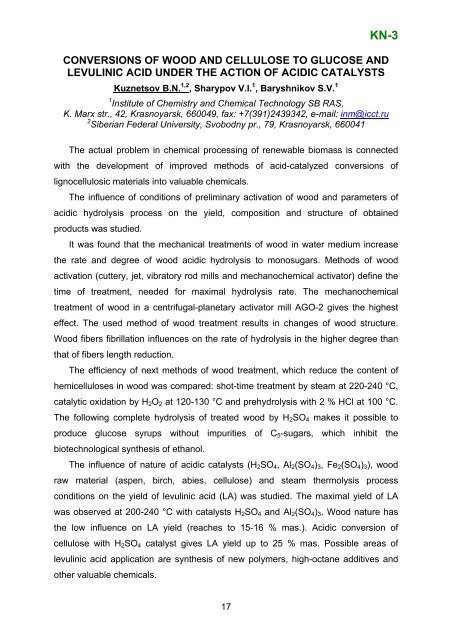Boreskov Institute of Catalysis SB RAS, Novosibirsk, Russia
Boreskov Institute of Catalysis SB RAS, Novosibirsk, Russia
Boreskov Institute of Catalysis SB RAS, Novosibirsk, Russia
- No tags were found...
You also want an ePaper? Increase the reach of your titles
YUMPU automatically turns print PDFs into web optimized ePapers that Google loves.
KN-3CONVERSIONS OF WOOD AND CELLULOSE TO GLUCOSE ANDLEVULINIC ACID UNDER THE ACTION OF ACIDIC CATALYSTSKuznetsov B.N. 1,2 , Sharypov V.I. 1 , Baryshnikov S.V. 11 <strong>Institute</strong> <strong>of</strong> Chemistry and Chemical Technology <strong>SB</strong> <strong>RAS</strong>,K. Marx str., 42, Krasnoyarsk, 660049, fax: +7(391)2439342, e-mail: inm@icct.ru2 Siberian Federal University, Svobodny pr., 79, Krasnoyarsk, 660041The actual problem in chemical processing <strong>of</strong> renewable biomass is connectedwith the development <strong>of</strong> improved methods <strong>of</strong> acid-catalyzed conversions <strong>of</strong>lignocellulosic materials into valuable chemicals.The influence <strong>of</strong> conditions <strong>of</strong> preliminary activation <strong>of</strong> wood and parameters <strong>of</strong>acidic hydrolysis process on the yield, composition and structure <strong>of</strong> obtainedproducts was studied.It was found that the mechanical treatments <strong>of</strong> wood in water medium increasethe rate and degree <strong>of</strong> wood acidic hydrolysis to monosugars. Methods <strong>of</strong> woodactivation (cuttery, jet, vibratory rod mills and mechanochemical activator) define thetime <strong>of</strong> treatment, needed for maximal hydrolysis rate. The mechanochemicaltreatment <strong>of</strong> wood in a centrifugal-planetary activator mill AGO-2 gives the highesteffect. The used method <strong>of</strong> wood treatment results in changes <strong>of</strong> wood structure.Wood fibers fibrillation influences on the rate <strong>of</strong> hydrolysis in the higher degree thanthat <strong>of</strong> fibers length reduction.The efficiency <strong>of</strong> next methods <strong>of</strong> wood treatment, which reduce the content <strong>of</strong>hemicelluloses in wood was compared: shot-time treatment by steam at 220-240 °C,catalytic oxidation by H 2 O 2 at 120-130 °C and prehydrolysis with 2 % HCl at 100 °C.The following complete hydrolysis <strong>of</strong> treated wood by H 2 SO 4 makes it possible toproduce glucose syrups without impurities <strong>of</strong> C 5 -sugars, which inhibit thebiotechnological synthesis <strong>of</strong> ethanol.The influence <strong>of</strong> nature <strong>of</strong> acidic catalysts (H 2 SO 4 , Al 2 (SO 4 ) 3 , Fe 2 (SO 4 ) 3 ), woodraw material (aspen, birch, abies, cellulose) and steam thermolysis processconditions on the yield <strong>of</strong> levulinic acid (LA) was studied. The maximal yield <strong>of</strong> LAwas observed at 200-240 °C with catalysts H 2 SO 4 and Al 2 (SO 4 ) 3 . Wood nature hasthe low influence on LA yield (reaches to 15-16 % mas.). Acidic conversion <strong>of</strong>cellulose with H 2 SO 4 catalyst gives LA yield up to 25 % mas. Possible areas <strong>of</strong>levulinic acid application are synthesis <strong>of</strong> new polymers, high-octane additives andother valuable chemicals.17
















